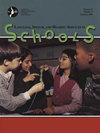2岁时的交流特征如何预测9-10岁脑瘫儿童的预后?
IF 2.9
3区 医学
Q1 AUDIOLOGY & SPEECH-LANGUAGE PATHOLOGY
Language Speech and Hearing Services in Schools
Pub Date : 2025-05-19
DOI:10.1044/2025_lshss-24-00089
引用次数: 0
摘要
目的早期识别发育轨迹分化对优化脑瘫儿童的沟通干预具有重要意义。本研究的目的是检验2岁时的交流特征是否能预测9-10岁时CP儿童的言语、语言和交流结果。方法23名CP儿童(年龄= 9;10[年;月])参加了这项研究,该研究由3个相互排斥的2岁言语语言特征组成:尚未说话(n = 10)、新出现的说话者(n = 9)和已经说话者(n = 4)。使用广义线性回归和Kruskal-Wallis秩和检验,我们检验了2岁的语音语言概况是否能预测9-10岁的语音、语言和交流结果。9-10岁时的结果通过分类系统、自发语言样本、诱导语音任务和父母报告获得。结果基于2年的言语语言特征,我们发现9-10岁的言语、语言和交流结果存在显著差异。具体来说,两岁时不会说话的孩子比两岁时开始说话或已经说话的孩子有更多的限制结果。结论本研究结果提供了初步证据,表明早期沟通干预可以而且应该根据两岁时的沟通能力进行区分,以最大限度地提高CP儿童的后期沟通效果。本文章由计算机程序翻译,如有差异,请以英文原文为准。
How Well Do Communication Profiles at 2 Years of Age Predict Outcomes at 9-10 Years of Age in Children With Cerebral Palsy?
PURPOSE
Early identification of diverging developmental trajectories is important to optimize communication interventions for children with cerebral palsy (CP). The aim of this study was to examine if communication profiles at 2 years of age predicted speech, language, and communication outcomes at 9-10 years of age in children with CP.
METHOD
Twenty-three children with CP (Mage = 9;10 [years;months]) participated in the study comprising of three mutually exclusive 2-year speech-language profiles: not yet talking (n = 10), emerging talkers (n = 9), and established talkers (n = 4). Using generalized linear regression and Kruskal-Wallis rank sum tests, we examined if 2-year speech-language profiles predicted speech, language, and communication outcomes at 9-10 years of age. Outcomes at 9-10 years of age were obtained from classification systems, spontaneous language samples, elicited speech tasks, and parent report.
RESULTS
Based on 2-year speech-language profiles, we found significant differences in speech, language, and communication outcomes at 9-10 years of age. Specifically, children who were not talking at 2 years of age had more restricted outcomes than children who were emerging or established talkers at 2 years of age.
CONCLUSION
Our study's results provide preliminary evidence that early communication interventions can and should be differentiated based on communication abilities at 2 years of age to maximize later communication outcomes for children with CP.
求助全文
通过发布文献求助,成功后即可免费获取论文全文。
去求助
来源期刊

Language Speech and Hearing Services in Schools
Social Sciences-Linguistics and Language
CiteScore
4.40
自引率
12.50%
发文量
165
期刊介绍:
Mission: LSHSS publishes peer-reviewed research and other scholarly articles pertaining to the practice of audiology and speech-language pathology in the schools, focusing on children and adolescents. The journal is an international outlet for clinical research and is designed to promote development and analysis of approaches concerning the delivery of services to the school-aged population. LSHSS seeks to advance evidence-based practice by disseminating the results of new studies as well as providing a forum for critical reviews and meta-analyses of previously published work.
Scope: The broad field of audiology and speech-language pathology as practiced in schools, including aural rehabilitation; augmentative and alternative communication; childhood apraxia of speech; classroom acoustics; cognitive impairment; craniofacial disorders; fluency disorders; hearing-assistive technology; language disorders; literacy disorders including reading, writing, and spelling; motor speech disorders; speech sound disorders; swallowing, dysphagia, and feeding disorders; voice disorders.
 求助内容:
求助内容: 应助结果提醒方式:
应助结果提醒方式:


